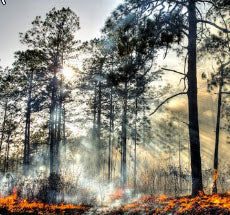
Gopher Tortoises and Fire: A Symbiotic Relationship
Share
Gopher Tortoises and Fire: A Symbiotic Relationship |
Gopher tortoises have adapted to fire-prone environments and benefit from periodic controlled burns. These burns are an essential part of maintaining healthy ecosystems, particularly in the longleaf pine forests and scrub habitats where gopher tortoises are commonly found.
Controlled Burns: Controlled burns, also known as prescribed fires, are carefully planned and managed to mimic natural fire cycles. These burns help maintain open habitats, reduce overgrowth, and promote the growth of fresh vegetation. Fire management practices are essential for maintaining the health of these ecosystems. By reducing the buildup of dead plant material, controlled burns decrease the risk of catastrophic wildfires and create a mosaic of habitats that support diverse plant and animal communities.
Benefits to Gopher Tortoises: Gopher tortoises benefit from controlled burns in several ways. The fires help maintain the open, sunny environments that tortoises prefer. By reducing dense vegetation, controlled burns make it easier for tortoises to move, forage, and find mates. The fresh growth of grasses, herbs, and other plants after a burn provides a rich food source for tortoises. Additionally, the heat from the fires helps to control populations of pests and diseases that could otherwise harm tortoise populations.
Ecological Impact: The symbiotic relationship between gopher tortoises and fire extends beyond the tortoises themselves. The open habitats created by controlled burns support a wide range of species, from plants and insects to birds and mammals. Many of these species rely on the conditions created by fire to thrive. For example, the red-cockaded woodpecker, an endangered bird species, depends on the open pine forests maintained by fire for nesting and foraging. Similarly, many plant species, such as wiregrass and longleaf pine, are adapted to fire and require periodic burns for their seeds to germinate.
Challenges and Strategies: Despite the benefits, implementing controlled burns can be challenging. Weather conditions, air quality regulations, and public perception can all influence the ability to conduct burns safely and effectively. Fire management teams must carefully plan and execute burns to ensure the safety of both the tortoises and their habitats. Collaboration with landowners, government agencies, and conservation organizations is essential for overcoming these challenges and achieving long-term success.
By understanding and harnessing the benefits of controlled burns, we can help maintain healthy ecosystems and support the conservation of gopher tortoises and other fire-adapted species.
